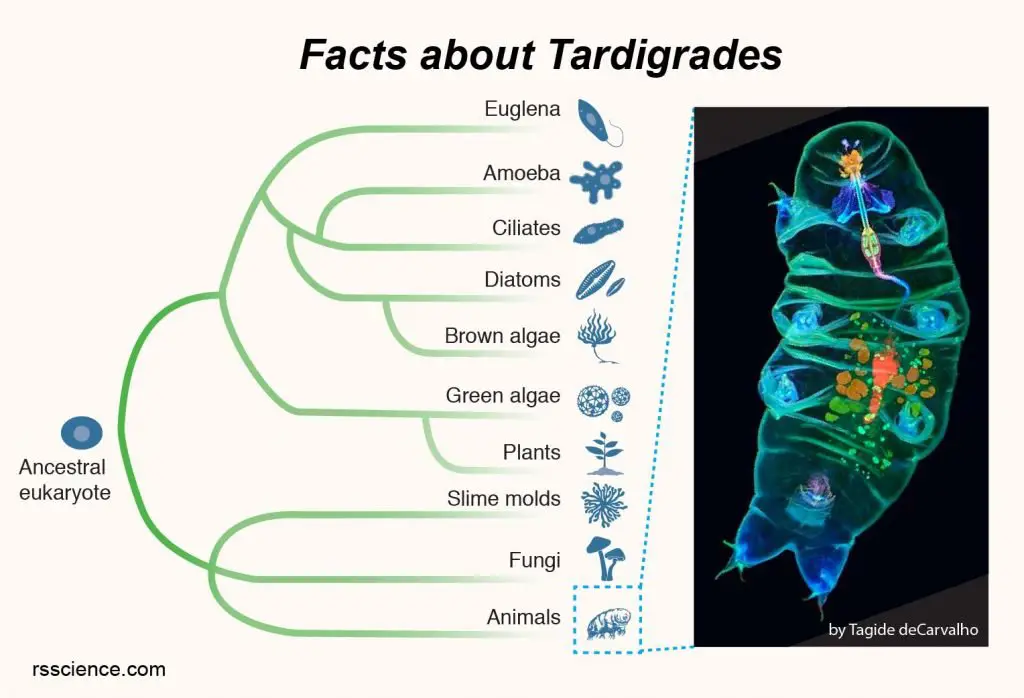This article covers
What are tardigrades? A quick overview of tardigrades
Tardigrades, also known as water bears or moss piglets, are an interesting but little-studied phylum of animals. Tardigrades look like chubby, microscopic bears walking slowly with eight short legs. Of no doubt, Tardigrades are the cutest tiny creatures you can find under a microscope.
[In this video] Tardigrades are the cutest tiny creatures you can find under a microscope.
Tardigrades represent a very successful group of animals. They have been studied for their fascinating ability to survive in extremely harsh conditions. Tardigrades can perform Cryptobiosis and turn into a dried-up dormant tun that can survive for years without water. The tun is resistant to extremely high temperature, pressure, irradiation, and freezing. Once encountering water, the tardigrades rehydrate and come back to life in a few minutes.

Tardi-what? Interesting facts about tardigrades
- Tardigrade means “slow stepper.” It also has a cute nickname, “Water bear,” and looks like an adorable miniature bear.
- Tardigrades are tiny but not simple. They have many organs similar to humans.
- Hardy-grades! Tardigrades were crowned the “Most Extreme” survivor on Earth.
- Tardigrades can survive in hot springs, in the deep ocean, under solid layers of ice, and even after exposure to deadly irradiation. We call them “extremophile.”
- Tardigrades can cope with extremely high (150oC) and low (-270oC) temperatures that would kill other organisms.
- Tardigrades don’t crack under pressure. They are totally fine, even at the bottom of the Mariana Trench.
- Tardigrades can live in space (sort of).
- Tardigrades can lose up to 99% of their water content and enter into cryptobiosis where all metabolisms stop. They survive (as “tun”) for years without water. Dried tun can be carried on the wind, like a seed or spore.
- We may have already populated tardigrades on the Moon! How? Because of a crashed spacecraft.
[In this video] Far too many water bears in the lab! (Goldstein Lab at UNC-Chapel Hill)
If you want to know the tardigrades or “The Toughest Animals on the Earth” more in detail, keep reading this article.

Part 1. The Basic of Tardigrades – Name, Size, Classification, and Evolution
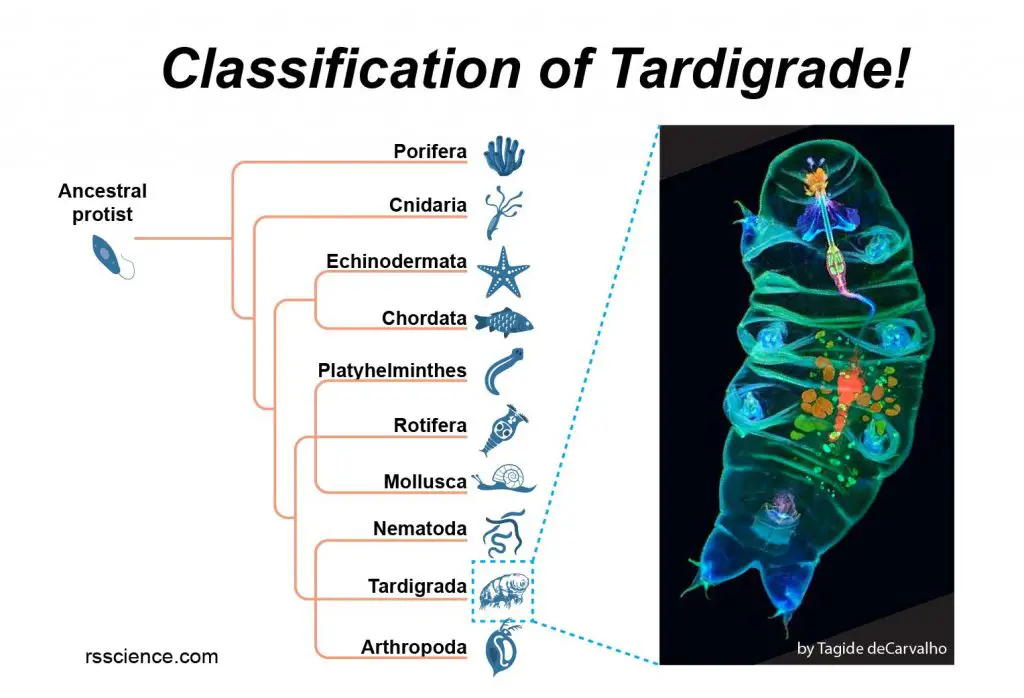
[In this figure] Tardigrade taxonomy – the phylogenetic tree. Tardigrades are multi-cellular, invertebrate animals. Compared to other microscopic organisms, tardigrades are pretty advanced in the aspect of evolution.
Photo credit: Tagide deCarvalho / Olympus Global Image of the Year
Classification of tardigrades
Scientists place the tardigrades in the Kingdom of Animalia as listed below:
Scientific classification
Kingdom: Animalia
Subkingdom: Eumetazoa
Clade: ParaHoxozoa
Clade: Bilateria
Clade: Nephrozoa
(unranked): Protostomia
Superphylum: Ecdysozoa
(unranked): Panarthropoda
Phylum: Tardigrada (Spallanzani, 1777)
Classes: Eutardigrada, Heterotardigrada, Mesotardigrada (dubious)(Reference: wiki)
The phylum of tardigrada
Tardigrades are so unique that we have to give them their own Phylum, called Tardigrada. There are about 1,300 known species in the phylum Tardigrada. The common features are eight-legged segmented micro-animals.
Phylum Tardigrada is subdivided into two classes: Eutardigrada and Heterotardigrada. Classification of tardigrades is mainly based on the morphology of armor, cuticle, claws/digits, feeding apparatus, and eggshells.
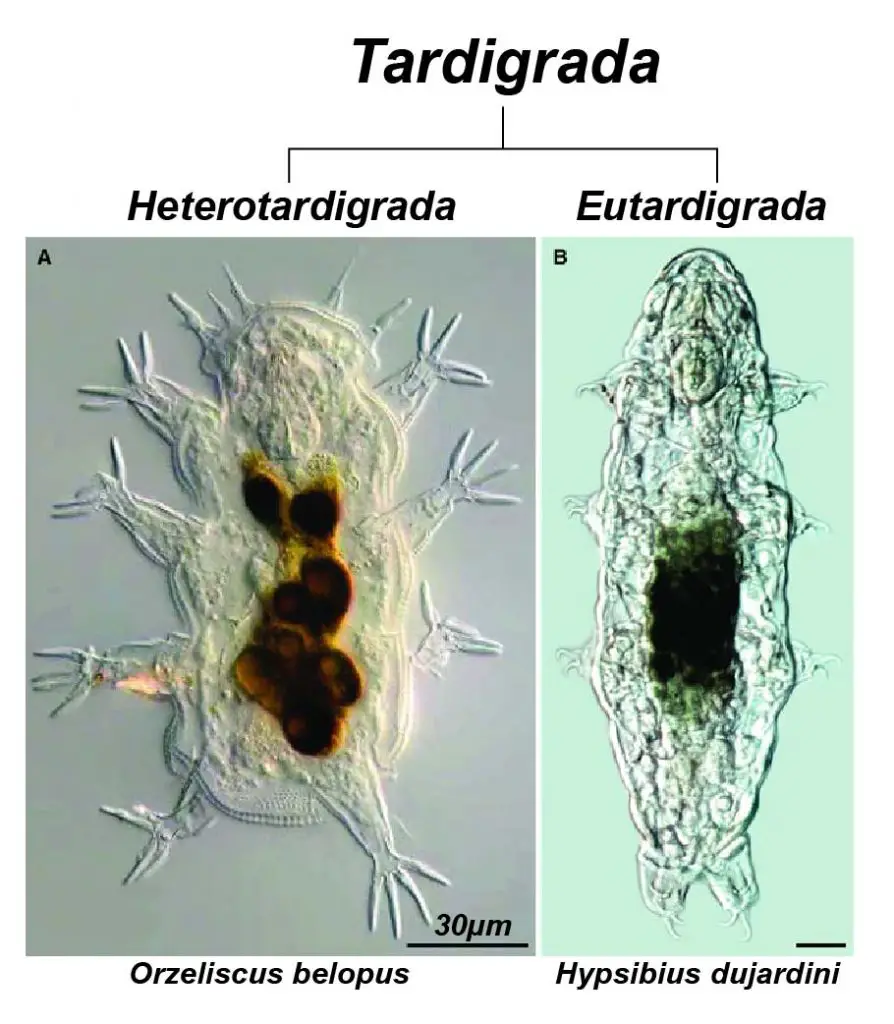
[In this figure] Representatives of the two major tardigrade subgroups: (A) Orzeliscus belopus, a marine Heterotardigrade. (B) Hypsibius dujardini, a Eutardigrade.
Photo credit: Evolutionary developmental biology of invertebrate.
Eutardigrada is characterized by a long body (up to 1 mm in length) with a smooth cuticle. They are further split into two subgroups, Parachela and Apochela. Our general impression of what a water bear looks like came from Eutardigrada tardigrades.
[In this video] A typical Eutardigrada tardigrade under the microscope.
Heterotardigrada typically does not exceed 500 μm in length and exhibits a highly diverse cuticle and legs with four separate digits. Heterotardigrada is also subdivided into two groups: Arthrotardigrada and Echiniscoidea. Some Heterotardigrada tardigrades are marine species and some of them have unique armored cuticles (plate) with long, exposed spikes.
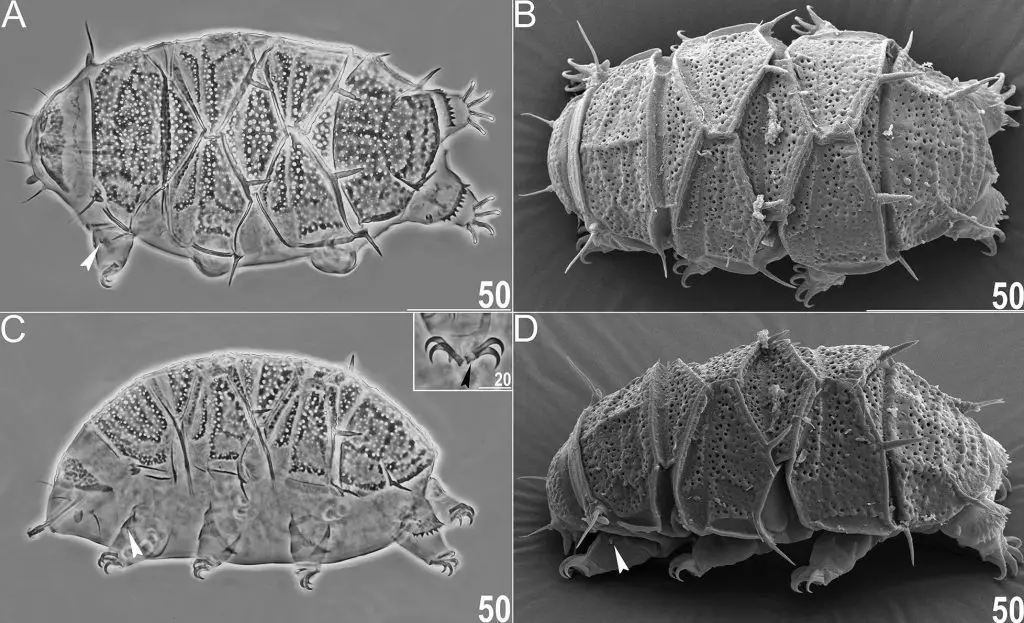
[In this figure] Phase-contrast (Left) and SEM (Right) images of Echiniscus succineus (a Heterotardigradaspecies) with armored cuticle on its back.
Major differences between Heterotardigrada and Eutardigrada are listed:
| Heterotardigrada | Eutardigrada | |
| Size | shorter | longer |
| Cuticle | thick, rough | smooth |
| Plate | yes, with pore patterns | no |
| Sensory hair | sensory papilla/spine exposed | small or hidden |
| Claw | four per foot | two per foot |
| Gonoduct | opening directly to the outside | opening into the rectum |
| Habitation | Most aquatic; some are marine; few are terrestrial | terrestrial or aquatic |
Note: there is a third class, Mesotardigrada, which has only one species. However, the reference material was destroyed in an earthquake, and very little was known about this species. (Source: Wiki)
How big are tardigrades?
Tardigrades are usually about 0.5 mm long when fully grown. The biggest adults may reach a body length of 1.5 mm, the smallest below 0.1 mm. Newly hatched tardigrades may be smaller than 0.05 mm. Eutardigrade tardigrades are usually elongated; Heterotardigrada species are short and plump.
Most tardigrades are semi-transparent. Some are with color, like red, yellow, black, etc.
How many cells does a tardigrade have?
Tardigrades are multicellular animals with around 4,000 cells (in adults), depending on the species. Some species have as many as 40,000 cells.
Tardigrades are fairly unique in that they are hatched already having all of the cells they will have for the rest of their lifespan. Tardigrades are eutelic, meaning all adult tardigrades of the same species have the same number of cells. They grow mainly by enlarging the size of cells, not by increasing the number of cells.
[In this Video] A Tardigrade under a fluorescence microscope showing its muscles (green) and cell nuclei (blue) labeled by different fluorescent dyes.
Where did the name “Tardigrades” and “Water Bears” come from?
Tardigrades were first described by the German zoologist – Johann August Ephraim Goeze in 1773, who called them “little water bears”. He was the first person who discovered tardigrades. He also contributed a lot to the biology of aquatic invertebrates, particularly insects and worms.
In 1777, the Italian biologist – Lazzaro Spallanzani named them “Tardigrada” which means “slow steppers”
How long does tardigrade live?
They live between 3 months and 2.5 years in normal condition.
Part 2. The Anatomy Structure and Organ Systems of Tardigrades
The external anatomy of tardigrades
Body plan and legs
Let’s start looking at the external anatomy of a tardigrade. Tardigrade has a bilaterally symmetric, barrel-shaped body. Tardigrades have five body sections, a well-defined head, and four body segments, each of which has a pair of legs fitted with claws. Three pairs of legs are on each side of the body and the fourth pair of legs on the back.
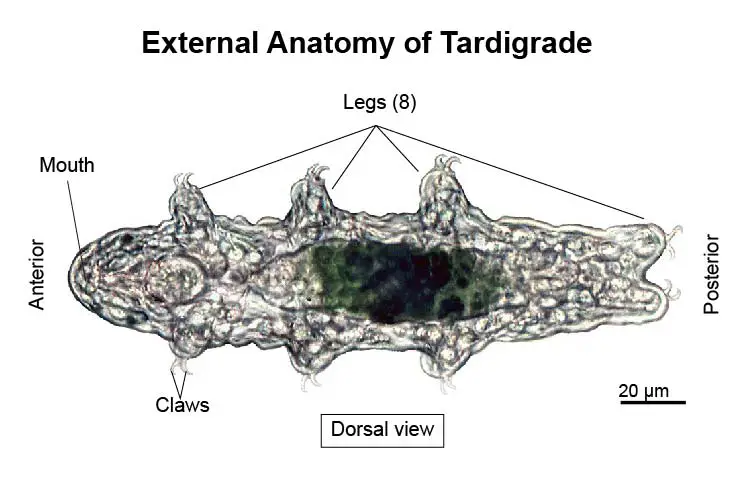
[In this figure] The external anatomy of a Eutardigrada tardigrade (Hypsibius dujardini) is labeled. (Image modified from eLife 2016;5:e11117)
Cuticle
The bodies of tardigrades are covered by a layer of cuticles like wearing armor. Tardigrades molt and produce new cuticles as they grow.
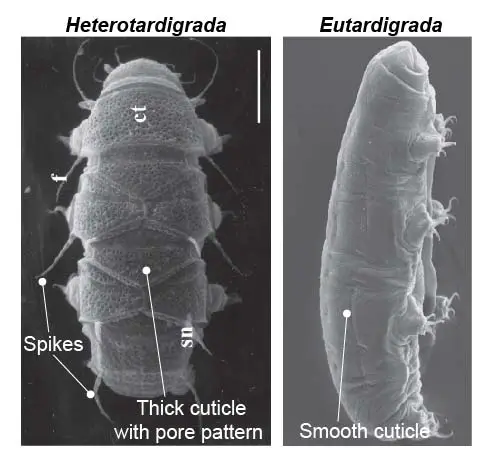
[In this figure] SEM images showing the difference of cuticles in Heterotardigrades (left) and Eutardigrades (right).
Heterotardigrades have thick cuticles (plates) with pore patterns and spikes, whereas Eutardigrades have much smoother cuticles.
Photo credit: Chapter 17 – Phylum Tardigrada
Claws
The claws (or digits) vary in different species from bear-like claws to straight spike-like digits. These claws are used for grasping on mosses and aquatic plants.
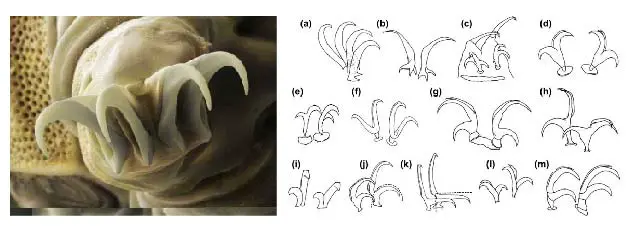
[In this figure] Left: A colored SEM image showing the close view of bear-like claws of a Tardigrade. Right: Diagrammatic representation of various claw morphologies in tardigrades.
Photo credit: Chapter 17 – Phylum Tardigrada
[In this video] A strange tardigrade belonging to genus of Batillipes. Batillipes has feet like a gecko to walk quickly over sand grains to escape its predators.
Head
The first segment of Tardigrade’s body, called the cephalic segment, is its head with a tube-shaped mouth (proboscis), two simple eyes (ommatidia), and sensory hairs (cirrus and papilla).
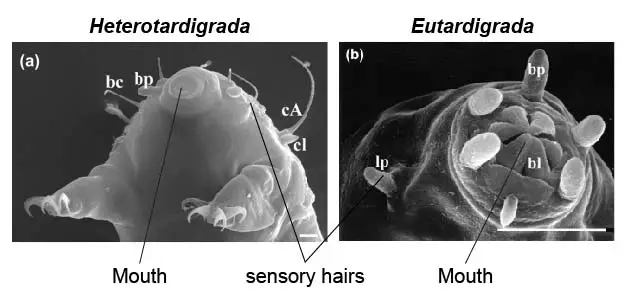
[In this figure] SEM images of the heads of Heterotardigrades (left) and Eutardigrades (right). Generally speaking, these sensory hairs are external in Heterotardigrades, whereas Eutardigrades have sensory receptors under the cuticle.
Photo credit: Chapter 17 – Phylum Tardigrada
Mouth
The external appearance of the tardigrade’s mouth is like a tube.

[In this figure] Detail of the mouth of a tardigrade. Colored image of the scanning electron microscope (SEM).
Photo by Eye of Science/Science Photo Library
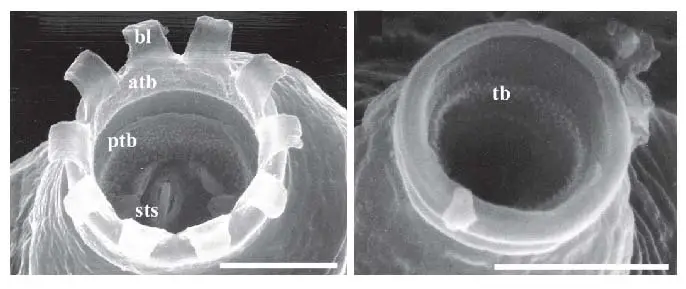
[In this figure] Two examples of tubular mouths of Tardigrades: Dactylobiotus selenicus (left); Isohypsibius lunulatus (right). SEM images, Scale bars=5μm.
Photo credit: Chapter 17 – Phylum Tardigrada
Quick summary of the external anatomy
From the external view, you can easily identify a tardigrade with a well-defined head, a tubular mouth, and eight legs with claws.
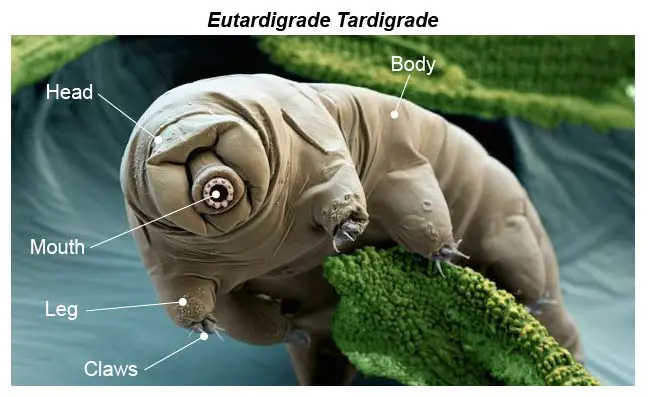
[In this image] A colored SEM image of a Eutardigrada tardigrade (Macrobiotus sapiens) on a piece of moss.
Photo credit: Nicole Ottawa & Oliver Meckes.
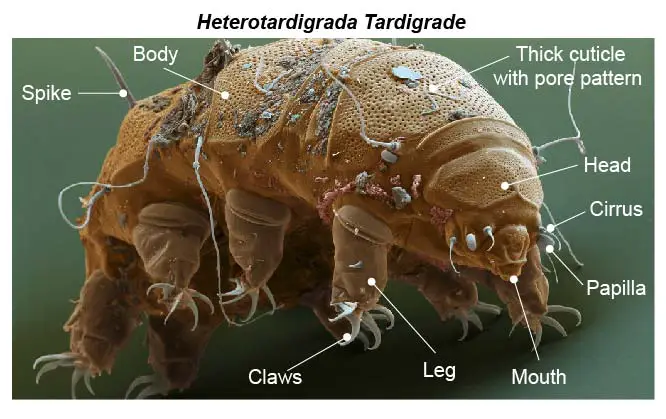
[In this image] A colored SEM image of a Heterotardigrada tardigrade.
The internal anatomy of tardigrades
Since tardigrades are semi-transparent, you may see some internal structures when you observe a tardigrade under a microscope.
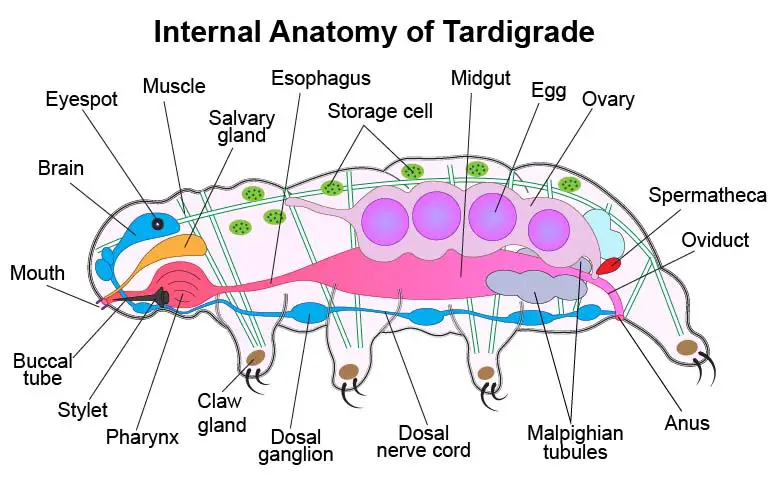
[In this image] The internal anatomy of a tardigrade.
Tardigrade’s anatomy is similar to ours – they have muscles, brains, eyes, and stomachs. They have pretty decent digestive, reproduction, and neural systems with several organs.
However, tardigrades do not have tiny bones. Instead, tardigrades have a special “skeleton” that works like a rubber glove filled with water. The liquid that fills tardigrades is called hemolymph, which is full of nutrients, much like our blood (but no circulatory system). Unlike us, they don’t have lungs; instead, they soak up oxygen straight from the water.
Tardigrade’s organs and their functions
| Name | Function |
| Skeleton system | |
| Cuticle | A flexible but strong outer covering, similar to insect’s exoskeleton. |
| Claw | Curved, pointed structures on feet to grasp. |
| Claw gland | A group of cells that release material to grow claws. |
| Muscle | Tardigrades have muscles that attach to the internal surface of their cuticle. The body muscles move the tardigrade’s legs and body around. |
| Digestive system | |
| Mouth | An opening on the face where food is taken into the body. |
| Stylet | A sharp mouth structure that pierces plant cells so the contents can be sucked out. |
| Buccal tube | A tube that connects the mouth to the pharynx. |
| Pharynx | A muscular organ that works with the buccal tube to create suction for feeding. |
| Salivary Gland | Cells release chemicals, fluids, and enzymes into the mouth. |
| Esophagus | A tube that brings the food from pharynx to midgut. |
| Midgut | The place where most food digestion happens, like our stomach and intestine. |
| Anus | The opening through which waste from the midgut is removed from the body, and through which sperm and eggs can enter and exit. |
| Excretory system | |
| Malpighian tubules | Two organs on both sides that function like our kidney (a.k.a making pee). There are three tubes connecting to the midgut to remove water, chemicals, and waste from the body fluid. |
| Nervous system | |
| Brain | The central organ in the nervous system, responsible for controlling many body functions. |
| Eyespot | A simple eye that can sense light but can’t see color. |
| Nerve cord | A paired bundle of nerve fibers that connects nerves throughout the body. |
| Reproduction system | |
| Ovary | The female reproductive organ that makes eggs. |
| Testis | The male reproductive organ that makes sperm. |
| Ovotestis | Some tardigrades are both male and female at the same time (hermaphroditic). Their ovotestis makes both sperm and eggs. |
| Eggs | Female reproductive cells. |
| Spermatheca | An organ that stores sperm in the female body after mating. |
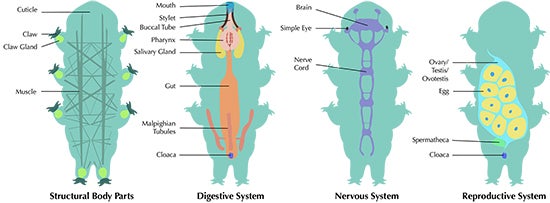
[In this figure] Tardigrade’s structural body parts, digestive system, and nervous system. (Image by Ioulia Bespalova)
Tardigrade’s feeding organs
Tardigrade has a tubular mouth. A buccal tube connects the mouth to a bulb-like pharynx which has several muscles to create a sucking force. Beside the buccal tube, there is a pair of stylets, which are used to pierce the plant cells, algae, or other microscopic animals, releasing the body fluids or cell contents. Then, the tardigrade can consume the content by sucking.
The pharynx connects to an esophagus, and then to a midgut that occupies much of the length of the body, which is the main site of digestion.
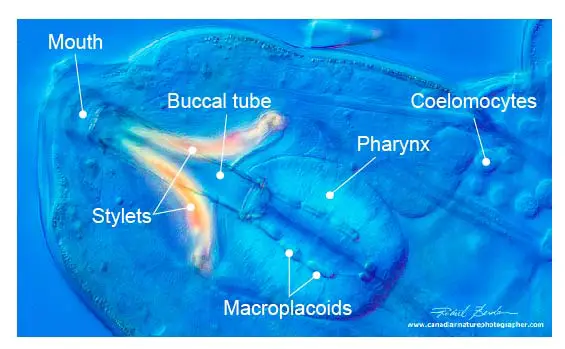
[In this image] Bucco-pharyngeal apparatus is the complex of feeding organs in a tardigrade.
Modified from The Canadian Nature Photographer.

[In this image] Many shiny granules were observed inside a tardigrade’s midgut under a polarized light microscope.
Photo source: The Canadian Nature Photographer.
Tardigrades use muscular bundles to move their bodies
There are several muscular bundles consisting of elongated muscle cells inside the body of a tardigrade. Usually, the muscular bundles anchor at one end to the internal side of the cuticle, and the other end to the legs or other moving parts.

[In this image] A Tardigrade is photographed with polarized light microscopy showing the muscle arrangements (yellow bundles).
Photo source: The Canadian Nature Photographer.

[In this figure] The muscular system of a Tardigrade with color codes for each segment and leg.
Photo source: Gross V and Mayer G, https://doi.org/10.1098/rsos.191159
Tardigrades have a central brain and nervous system
Tardigrades have a central brain atop a paired dorsal nervous system. In comparison, humans have a brain and a single dorsal nervous system (a spinal cord).
Tardigrades have a bilaterally symmetric dorsal nerve cord that runs the length of the body. The cord has one ganglion per segment, each of which produces lateral nerve fibers that run into the limbs.
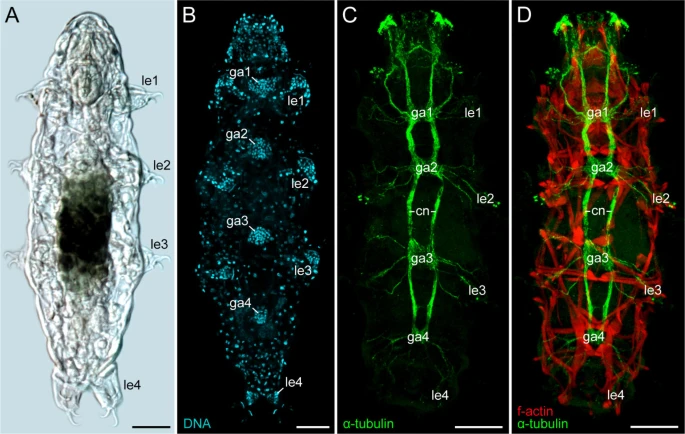
[In this image] A cool study using fluorescence microscopes and immunofluorescent staining to locate the nervous system and ganglia in a tardigrade.
DNA shows the clusters of cell nuclei (B). α-tubulin labels nerve fibers (C), and f-actin highlights the muscles (D).
Photo source: Mayer et al., https://doi.org/10.1186/1471-2148-13-230
Many species have a pair of simple eyes on the top of the brain. The eyes can sense the light but can’t see color. Some tardigrades (especially, Heterotardigrada) have numerous sensory bristles on the head and body to sense their environment.
Part 3. What Makes Tardigrades the Toughest Extremophiles?
What is an extremophile?
An extremophile is an organism that thrives in extreme conditions such as extreme salinity, high pressure, toxic chemical concentration, dry, or high/low temperature. Tardigrade is the most well-known example of extremophiles.
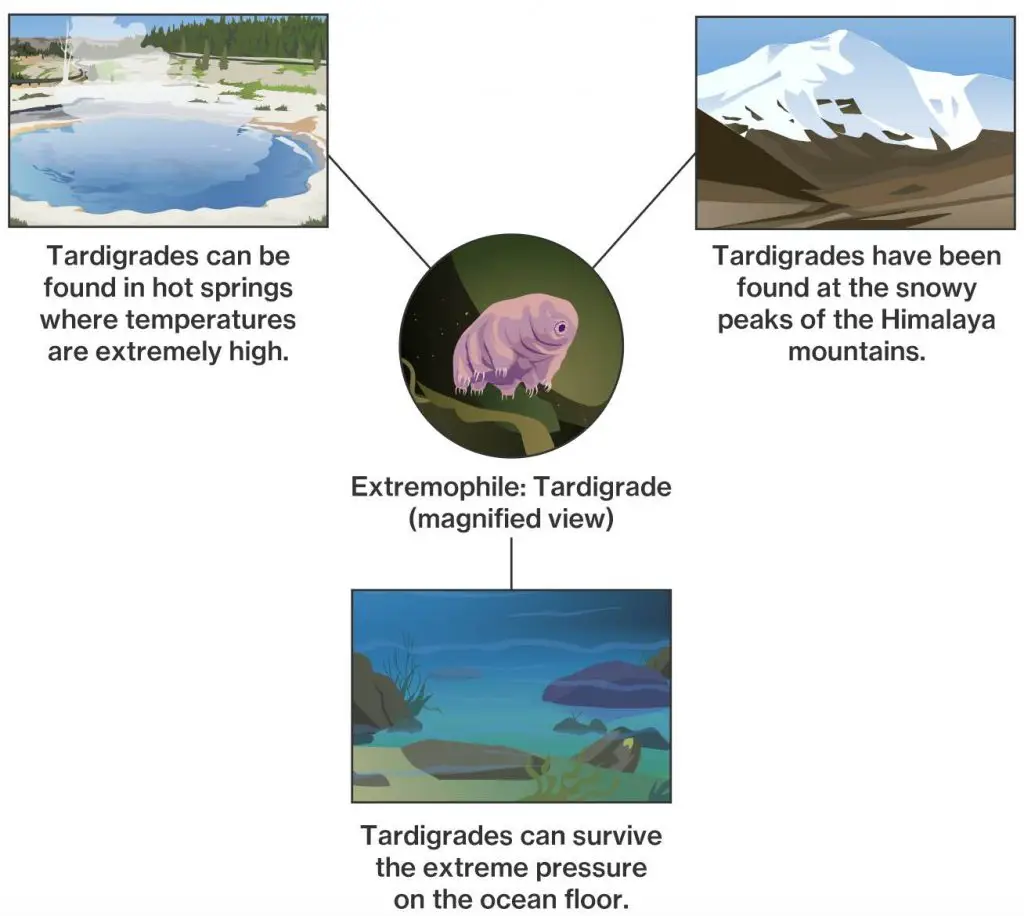
[In this image] Tardigrades can exist in places where life was once thought to be impossible.
Photo source: Course Hero.
What kinds of extreme environments can tardigrades live?
Tardigrades are incredibly resistant animals that have been studied to survive even in the following conditions:
- Dehydration: They can survive for 30 years under laboratory conditions without a single drop of water. Some sources even claim that tardigrades resisted up to 120 years or have been found in ice 2000 years old that are still able to revive.
- Extreme high/low temperature: If you boil one tardigrade, it survives. If you put it to temperatures near the absolute zero (-273ºC), it survives. They can survive in ranges from -270ºC to 150ºC.
- Extreme pressure: Tardigrades can survive from vacuum to 6,000 atmospheres, which is equal to 6 times the pressure in the deepest point on Earth, the Mariana Trench (11,000 meters deep).
- Lethal radiation: Tardigrades can withstand the bombardment of radiation at a dose 1000 times lethal to a human.
- Toxic chemicals: If they are immersed in ether or pure alcohol, they survive.
- Outer space: Tardigrades are the only animals that have survived into space without any protection. To survive in space, tardigrades have to deal with several harsh conditions in combination: vacuum, cosmic rays, and ultraviolet radiation 1,000 times higher than that of the Earth’s surface.
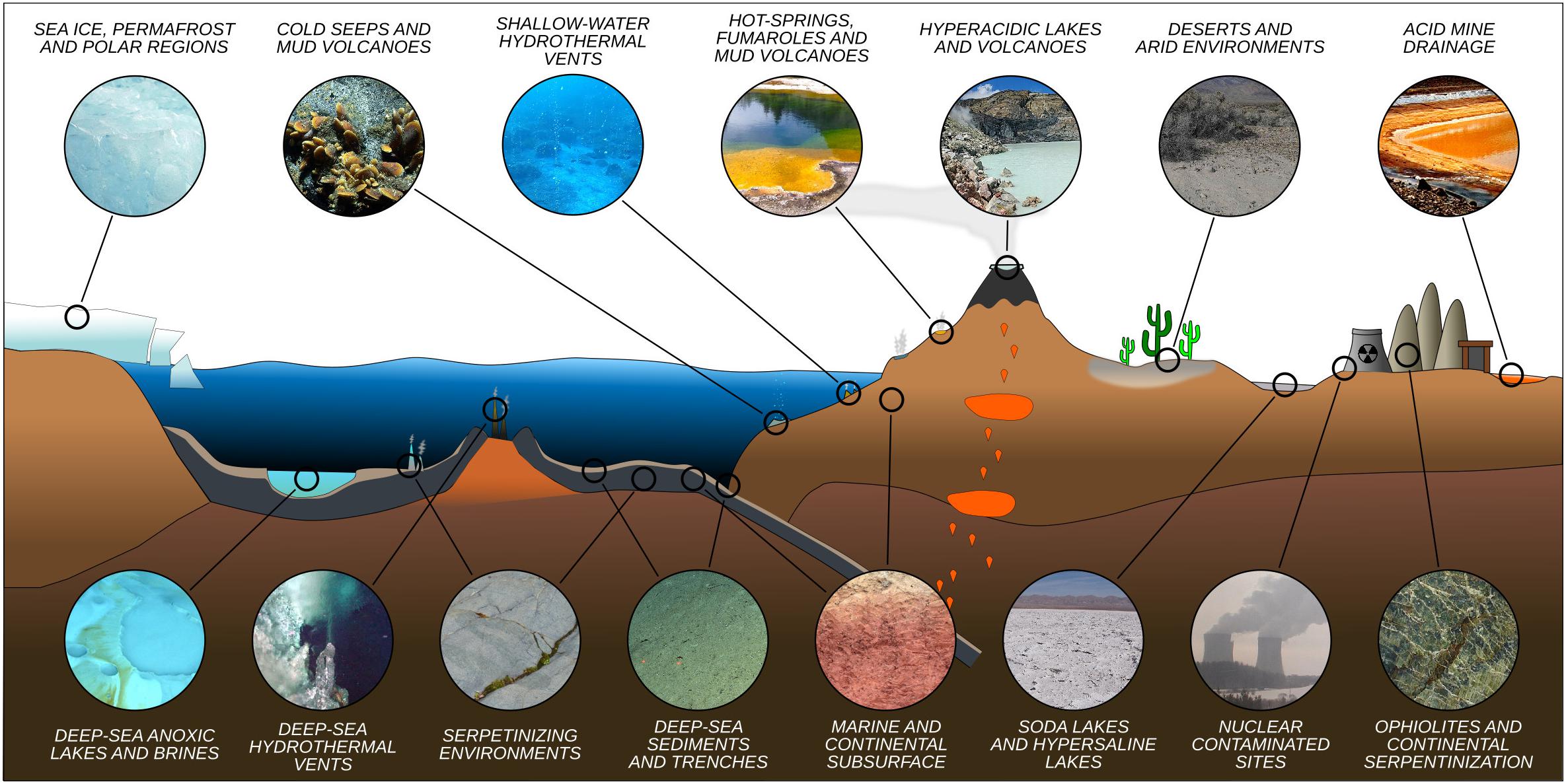
[In this image] The diversity of extreme environments on Earth.
Photo source: Merino et al., https://doi.org/10.3389/fmicb.2019.00780
What is tardigrade’s secret to survival?
Terrestrial (land) tardigrades are able to withstand such extreme conditions because they enter a “cryptobiosis” status when conditions are unfavorable. In principle, tardigrades enter cryptobiotic life by stopping all metabolic processes (called anabiosis) and shrinking into a dormant state. When environmental conditions return to being hospitable, the tardigrades can quickly return to their active states.
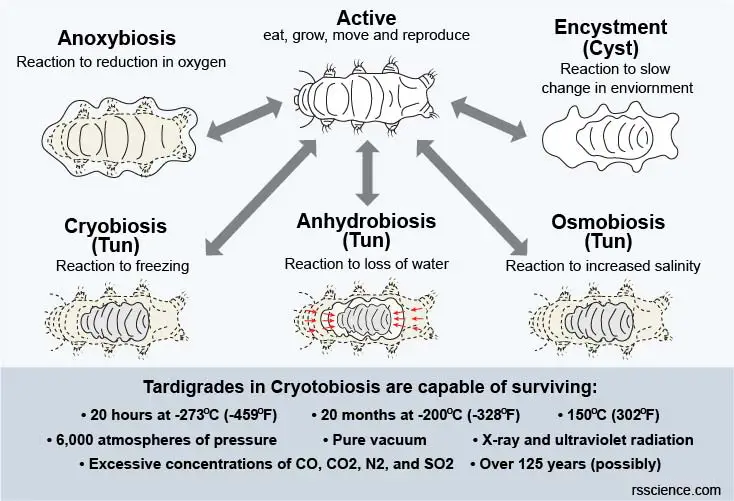
[In this image] Tardigrade’s survival kits: they can adapt to different forms of cryptobiosis according to the conditions they endure. However, extreme survivorship applies only to some species of terrestrial tardigrades. Marine and aquatic tardigrades may not evolve these characteristics because their environments are stable.
According to the extreme conditions they endure, the strategy of cryptobiosis is classified as:
- Anhydrobiosis: When the environment is drying up (dehydration), tardigrades enter a “tun status” by adopting a barrel shape to reduce its surface area and wrapping in a layer of wax to prevent water loss through transpiration. They also synthesize a sugar substitute for water, called trehalose, so that body structure and cell membranes remain intact (trehalose replaces the space of water). They can reduce the water content of their body to just 1% and then stop their metabolism almost completely (0.01% below normal).
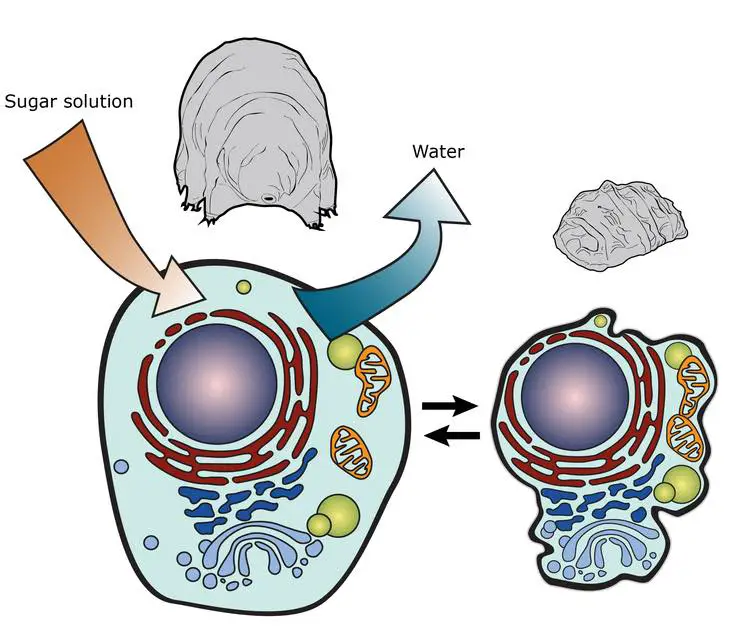
[In this figure] Tardigrades produce trehalose, a type of sugar, to replace the water in their cells. This minimally preserves the structures and functions of cell organelles.
Photo source: asknature.
- Cryobiosis: Under a low temperature (below 0oC), other cells and organisms will die due to the freezing of intracellular water. When the water of living beings crystallizes, the ice will tear and rupture cells, causing the cells to die. To combat this, tardigrades can enter Cryobiosis and utilize a type of protein called ‘tardigrade-specific intrinsically disordered protein’ (TDP) to stabilize the water. This forms a glass-like substance that prevents water molecules from fissuring the cells and keeps the cell structures intact.
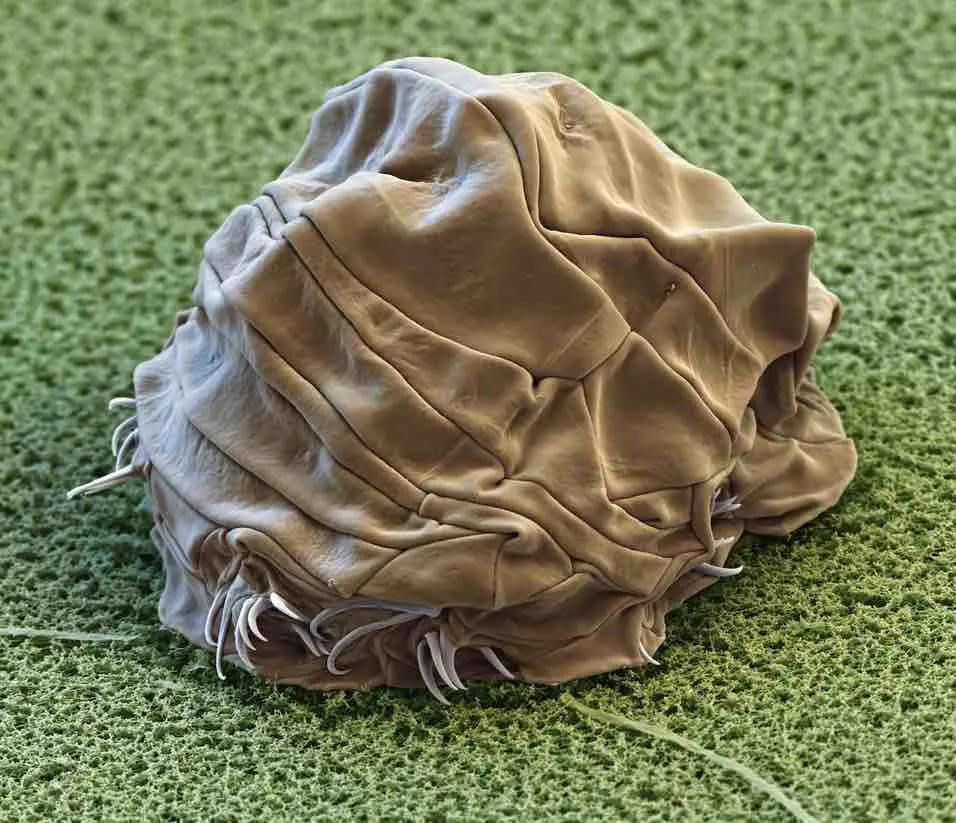
[In this image] A dehydrated tardigrade or tun.
Photo by Photo Science Library
- Anoxybiosis: In situations lacking oxygen (anoxia), the oxygen concentration isn’t high enough to sustain normal activity. Tardigrades will suspend their metabolism and become swollen by taking water. They stay immobile but can survive for prolonged periods of time.
- Osmobiosis: Osmobiosis occurs in response to increased salt concentration. Little is known about osmobiosis. It may involve a cessation of metabolism.
Tardigrades can also survive by entering the diapause status like insects:
- Encystment: Encystment usually happens when the environment slowly turns unsuitable for living in (i.e., long winter). During the encystment process, tardigrades reduce their body size by contracting and decreasing body movements up to a complete standstill. At the same time, they synthesize two or three layers of new cuticles to form contracted, oval-shaped cysts. Once the environment becomes favorable (i.e., spring), tardigrades can quickly (within minutes) recover from the dormancy.
- Resting egg: Eggs of tardigrades are pretty resistant due to the thick, protective shells. They can be preserved without hatching for years.

Tardigrades are DNA masters
In addition to the strategy of “staying low key” (a.k.a, cryptobiosis), Tardigrades also do a great job by managing their genetic materials or DNA. Radiation kills organisms mainly by destroying DNA. Surviving through intense radiation suggests that tardigrades have an especially effective DNA repair system. Scientists are very interested in this unique skill because it may help us fight cancer and aging one day.

[In this image] Recent genomic analysis surprisingly found that many genes in Tardigrades appear to have originated from other organisms.
Photo source: Boothby et al., https://doi.org/10.1073/pnas.1510461112
Tardigrades may not invent all these survival skills by themselves. In fact, they may borrow the knowledge from other organisms. Scientists found that tardigrades can incorporate foreign DNA from fungi, plants, bacteria, archaea, and viruses into their genome, creating a mosaic of DNA. This kind of horizontal gene transfer is rare in multicellular eukaryotes, but it has been found that tardigrades contain a high proportion of horizontally transferred genes. Scientists believe that the contribution of foreign DNA resulted in the evolution of survival strategies in tardigrades.
Cryptobiotic state helps tardigrades get around
Tardigrades have been discovered just about everywhere that anyone has looked, from the arctic to the equator, from intertidal zones to the deep ocean, and even at the top of forest canopies. How do tardigrades manage to find their way to the canopy of towering trees?
Most likely, the wind carries them. In the tun state, they are barely distinguishable from dust particles. But like spores, pollen, and seeds, the tuns can be carried by the wind everywhere. Once the tun lands in a suitable place, a tardigrade wakes up and starts a new life. Yet an unhappily placed tun can simply wait for a change in precipitation or perhaps a change in season. When conditions improve, life can begin again.
What can we learn from tardigrades?
The superpower of tardigrades can be very valuable for human beings.
- Cryonics – Cryonics is the low-temperature freezing and storage of a human body, with the speculative hope that resurrection may be possible in the future. We may need to learn from tardigrades about how to prevent cell death from the freezing process. In fact, these techniques have already been tested in living tissue preservation and organ transplantation.
- DNA repairing – DNA damage is the major cause of many diseases, including cancers and aging. Scientists are learning from tardigrades about their superior DNA repairing machinery.
- Astrobiology – Tardigrades open up our minds about how life could be. It may open new fields in space exploration for extraterrestrial life.
- Space travel – We may learn from tardigrades to deal with many problems to withstand long interplanetary travel during the human exploration of space. One day, these ideas from science fiction (for example, the “Dormant cabin”) may become a reality!

Tardigrades in space
In 2007 the ESA (European Space Agency) within the TARDIS project (Tardigrades In Space) left tardigrades for 10 days on the surface of the Foton-M3 spacecraft, and they survived the space travel. In 2011 NASA did the same, placing them outside of the space shuttle Endeavour, and the results were the same.
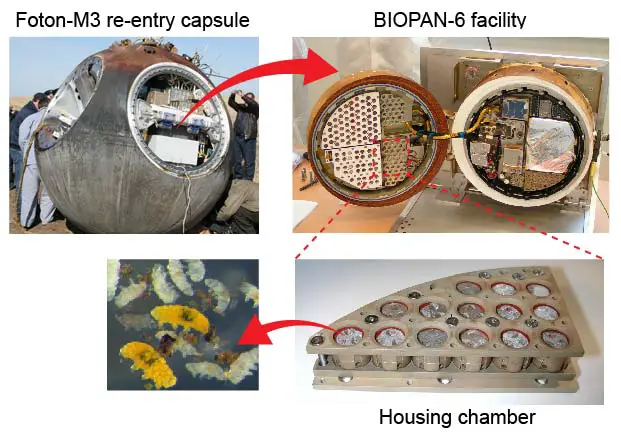
[In this image] Tardigrade’s space trip.
Foton-M3 re-entry capsule was shot into space on a rocket, and then came back to Earth. It carried a BIOPAN-6 facility that housed Tardigrades in specially designed chambers. The lid opened for 10 days in space and closed before the spaceship came back to Earth.
Photo source: askbiologist
There are probably tardigrades on the Moon
In April 2019, the Israeli lunar lander Beresheet crashed onto the Moon’s surface. Part of its cargo contained a colony of tardigrades, whom scientists believe are extremely likely to have survived during the impact (Source: https://www.wired.com/story/a-crashed-israeli-lunar-lander-spilled-tardigrades-on-the-moon/.)

[In this image] An illustration of a moon bear.
Photo source: Medium
Are tardigrades aliens?
There are a couple of reasons why some people believe that tardigrades might be alien life forms: their incredible ruggedness despite being so small and seemingly fragile. We didn’t find enough fossil records showing how tardigrades evolved. It feels like a perfect design of a living organism came from nowhere.
However, very few professional biologists believe that tardigrades originated somewhere other than Earth. Tardigrades are still much more similar to animals living here on Earth than any alien life form that is likely to be. For example, scientists once described tardigrades are worms growing legs by carrying insect’s genes.
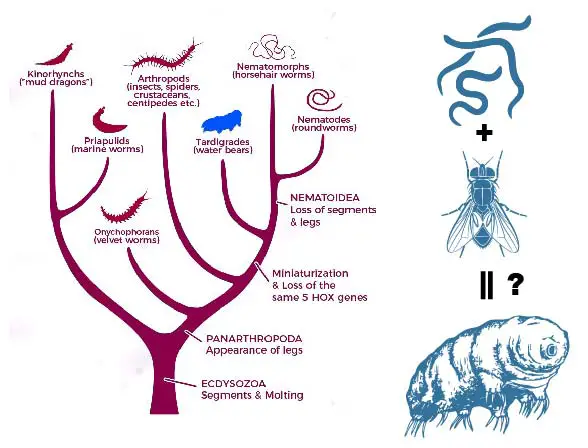
[In this figure] Tardigrade’s position in the tree of life has been debated for many years, but recently a consensus has emerged that tardigrades are part of a great group of molting animals that includes roundworms and insects.
Photo source: modified from scienceabc.
Tardigrades may have branched off from the rest of animal life in the very earliest days. Tardigrades have been around for more than 500 million years and have survived all five mass extinctions this planet has gone through. It may explain why Tardigrades are so different from other animals around us.
Part 4. The Habitation of Tardigrades – How do they move, eat, reproduce and perform other interesting behaviors?
Where do tardigrades live?
Water bears can live just about anywhere. Tardigrades are semi-aquatic. They prefer to live in sediment at the bottom of a lake, on moist pieces of moss, or other wet environments. There are also marine tardigrades. They can survive a wide range of temperatures and situations. They’ve been found even from frigid Antarctic glaciers to active lava fields.

What do tardigrades eat?
Most tardigrades eat algae and mosses. They use needle-like stylets that pierce from their mouths and penetrate plant cells. Then, they suck out plant cells’ contents through their tube-shaped mouths. Some tardigrades also live by feeding on other organisms such as bacteria and protozoa. A few tardigrades are carnivorous and may eat other microscopic animals like nematodes, rotifers, and other tardigrades.
[In this video] How do tardigrades feed
Are tardigrades immortal?
No. In their active state, most tardigrades have a lifespan around 2-4 months while some might live up to 2 years. However, under extreme conditions, tardigrades change to their dormant forms by reducing their metabolic rates and can survive for years or even decades.
How do tardigrades move?
Tardigrades move by grasping on the surface of plants with their claws. They also swim around using their legs as paddles, just like larger animals do.
[In this video] A water bear crawling around. Notice their legs movements and claws on their legs.
[In this video] Water bear walking on a stem of water plant.
How do tardigrades grow?
Tardigrades have three life stages – egg, juvenile, and adult.
When the egg hatches, out comes a small tardigrade. This part of their life is called the juvenile stage. Juvenile tardigrades work hard to eat and grow to adult size. To grow larger, tardigrades molt. That means they grow a new and bigger cuticle, then shed their old one. Depending on the species, tardigrades will molt four to twelve times. When they molt as adults, tardigrades will often lay their eggs inside their old molt to help protect the eggs.
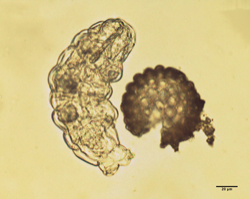
[In this image] This tardigrade just hatched out of its egg.
Photo source: askbiologist
How do tardigrades reproduce?
Tardigrades can reproduce both asexually and sexually, depending on the species or the environment. For asexual reproduction, females reproduce without being fertilized by any male (called Parthenogenesis).
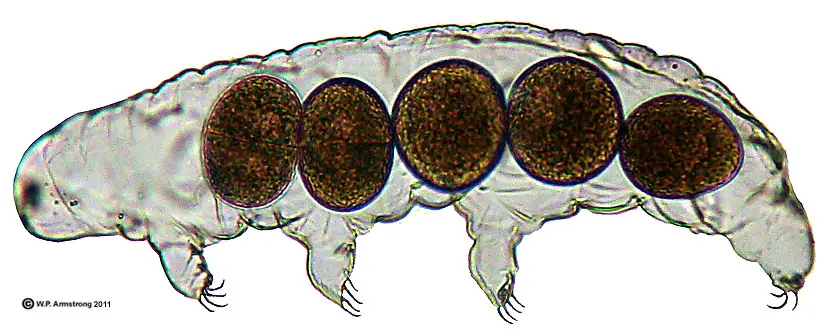
[In this image] A female molted cuticle carrying 5 eggs.
Photo source: palomar.edu
For those species that reproduce sexually, females are frequently larger and more common. Most fertilization is external. They lay one to 30 eggs at a time, depending on the species.
Some tardigrades lay eggs within a molted cuticle (called exuvium). Eggs develop inside the protection of the exuvium until the newborns crawl out of exuvium.
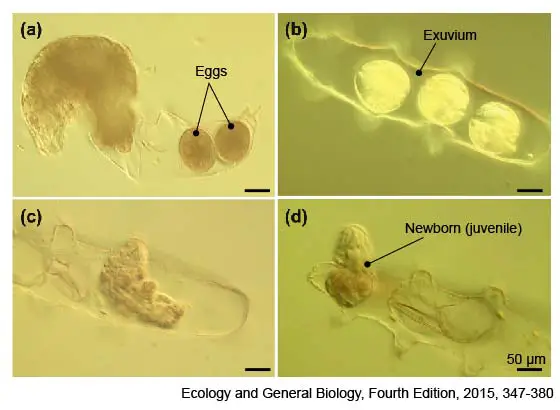
[In this figure] (A) Female tardigrade releasing the eggs in the exuvium; (B) eggs developing in the exuvium; (C) newborn (juvenile) trying to find the exit from the exuvium; (D) newborn (juvenile) crawling out of exuvium.
Image modified from Ecology and General Biology, Fourth Edition, 2015, 347-380
A few species, such as Pseudobiotus Kathmanae, express parental care of the eggs. The eggs remain attached to the back of the female, thus ensuring that the female cares for the eggs before they hatch.

[In this image] Female tardigrade is laying eggs.
Photo source: labcam.

[In this image] Colored SEM image of a Tardigrade’s egg showing unique structure.
Photo by Eye of Science/Science Photo Library
[In this video] A video showing the tardigrade embryos developing inside the eggs. You can see the increase of cell number by cell division.
Are tardigrades dangerous?
No, at least not to humans. There is no known disease related to tardigrades. There haven’t been any reported cases of food-borne tardigrade poisoning.
What is the role of tardigrades in ecology?
Tardigrades are nature’s pioneers. They colonize new, potentially harsh environments, and provide food for larger creatures that follow. Scientists say, for instance, that tardigrades may have been among the first animals to leave the ocean and settle on dry land.
Part 5. Observing Tardigrades under the Microscope
Observing tardigrades is easy and fun. Since tardigrades are almost everywhere, finding tardigrades is possible in specimens collected from all kinds of humid environments. You can try collecting water samples with bottom sediments or aquatic plants from scums and ponds. Mosses and lichens are great places to find tardigrades, too.

See my note about finding rotifers and water bears recovered from a piece of frozen moss collected during the winter.
Or see the ultimate guide of How to Collect and Photograph Water Bears from Dr. Robert Berdan.
You can also try to find marine tardigrades. They often have very elaborate spikes and specialized head appendages that make them particularly exciting to find and observe. Here is a very detailed guide about how to find them.
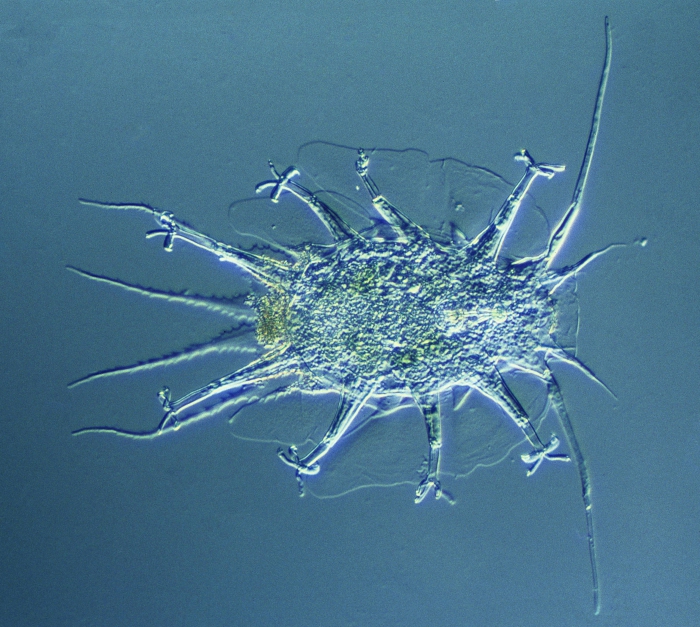
[In this image] A marine tardigrade (Floractus heimi).
Photo source: Worms.
Remember to leave some space for tardigrades when you observe them under the microscope. You may use a petri dish under a stereo microscope or concave microscopic slides for a compound microscope.
[In this video] Observing a tardigrade under a microscope.
Summary of Tardigrades
- “Tardigrade” means “slow stepper.” The name perfectly describes these slow-walking animals with eight legs.
- Tardigrade has a cute nickname, “Water bear,” and looks like adorable miniature bears.
- The phylum of Tardigrada includes two classes: Heterotardigrada and Eutardigrada.
- The tardigrade is a multicellular animal consisting of thousands of cells, but its size is microscopic (around 0.5 mm long).
- The body of the tardigrade is covered by a cuticle. Tardigrade has many organs, including muscular, digestive, nervous, excretory, and reproduction systems.
- The tardigrade is a famous extremophile, meaning it can survive in harsh conditions that would easily kill other organisms.
- Tardigrades can survive in hot springs, in the deep ocean, under solid layers of ice, and even after exposure to deadly irradiation. Tardigrades can even survive a space trip.
- Tardigrade’s survival strategy is to suspend all its body activity and enter a resting state known as cryptobiosis.
[In this video] Meet the tardigrade, the toughest animal on Earth.
References
Special thanks: Facebook group: Taiwan Tardigrades fans club
“Tardigrades” by Bob Goldstein and Mark Blaxter
“World list of Tardigrada”
“Phylogeny and Integrative Taxonomy of Tardigrada” by Aslak Jørgensen, Reinhardt M. Kristensen, and Nadja Møbjerg
“Tardigrades” by Willian Randolph Miller
“What Makes a Tardigrade?”
“Chapter 17. Phylum Tardigrada” by Diane R.Nelson, RobertoGuidetti, LorenaRebecchi. Ecology and General Biology, Fourth Edition, 2015, 347-380
Goldstein Lab at UNC Chapel Hill
“Experiences with dormancy in tardigrades”
“Water bears survive dehydration by turning into glass”
“25 of Your Most Frequently Asked Questions About Tardigrades Answered!”

